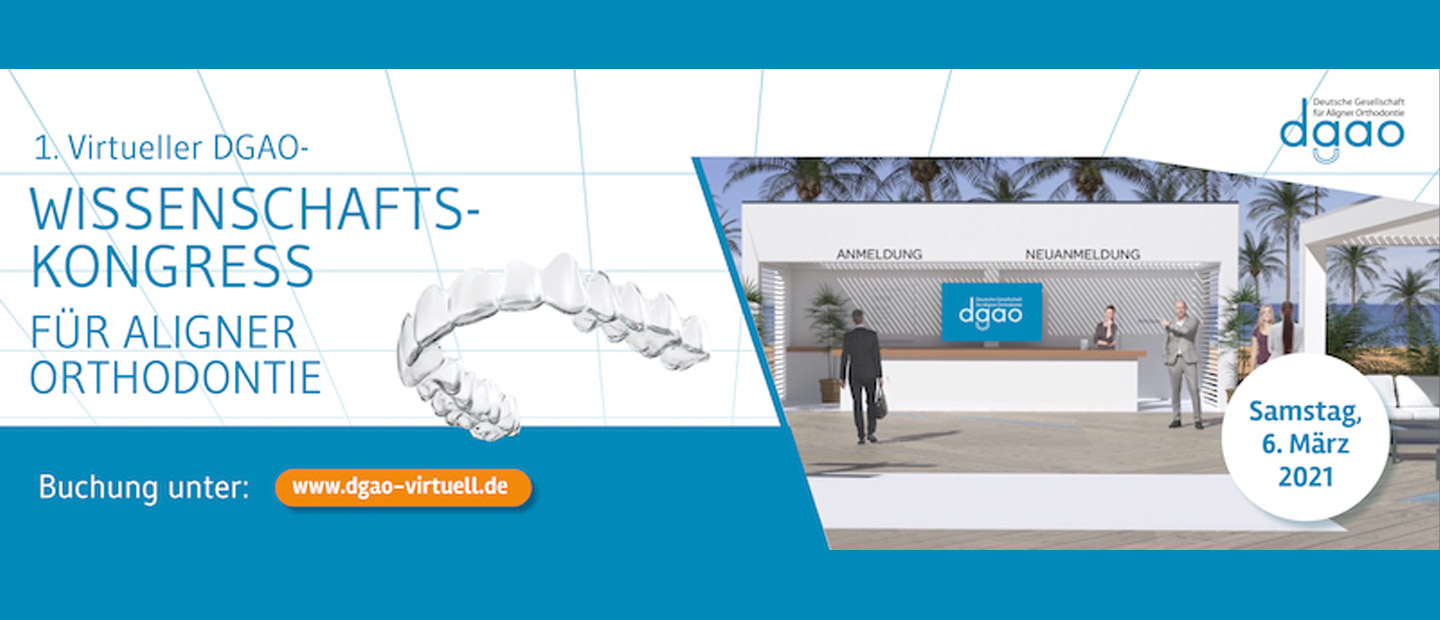After the German Society for Aligner Orthodontics (DGAO) was forced to cancel its 6th scientific congress in Cologne in November, more than 700 participants recently enjoyed the opportunity to learn about the latest developments and possibilities for treatment with aligners at the to follow the world's 1st virtual aligner congress. The positive response to this virtual concept once again underlines the pioneering role of the DGAO when it comes to breaking new ground.
Scientific live program, exhibition stands and workshop lounges: The virtual DGAO scientific congress for aligner orthodontics offered its participants everything they are familiar with from a real analogue congress - just without physical contact. Nevertheless, personal interaction was possible: avatars, virtual reality applications and numerous chat functions, live streams or video conferences ensured dynamics and allowed direct contact with speakers and exhibitors. It really doesn't get any more analogue than digital!
scientific programme
In a very lively live stream led by moderator Kerstin Sterz and the board members of the DGAO, a total of 16 top-class international speakers presented their latest findings on the topic: "Aligner orthodontics between science and practice" for a whole day.
After a short introduction to the virtual 3D space of the congress by conference president Dr. Julia Haubrich and Mrs. Kerstin Sterz opened the President of the DGAO, Prof. em. dr Rainer-Reginald Miethke, the 1st virtual congress for aligner orthodontics. In his opening speech, he emphasized that sadness and joy often go hand in hand: As sad as all the preliminary planning for an analogue congress ended, the 1st virtual congress could now take its course full of joy.
With a comprehensive overview of the current scanner market, Dr. Ingo Baresel, co-founder of the German Society for Oral Digital Impressions (DGDOA), finally as the first speaker the scientific program.
In a multi-centre, prospective study, Prof. Dr. Karl-Friedrich Krey from the University of Greifswald then presented the biological reality of computer-planned tooth movements with aligners.
dr Dietmar Zuran from Vienna showed the advantages and disadvantages of individual aligner systems in his clear overview.
Speaking from Italy, Achille Farina presented an efficient aligner hybrid procedure for necessary tooth root movements.
Doctoral student Sophia Weber from the University of Ulm presented another university contribution with her work on the biomechanical comparison of different aligner modifications in order to physically move incisors.
Finally, the morning ended with Dr. Tommaso Castroflorio also from Italy. In his presentation, he presented the possibilities that aligners offer for patients with an open bite and what role different attachment forms play in this.
After a detailed tour of the fair, another Italian opened the afternoon. Prof. Dr. Vincenzo D'Antò discussed aligner biomechanics in the treatment of Class II patients.
Printed vs. foil aligners under in-vitro conditions were then the subject of Prof. Dr. Margit Pichelmayer from the University of Graz.
dr Akim Benattia from France took up the challenge of treating patients with in-office aligners.
dr Julia Haubrich used numerous examples to show the need for interdisciplinary treatment in aligner orthodontics in complex treatment situations.
Seamless or the courage to leave gaps? This question went to Dr. Thomas Drechsler on the clinical handling of gaps in aligner therapy.
dr Kamy Malekian from Madrid dealt with the preventive treatment of impacted canines in prepuberty.
The question from Dr. Jörg Schwarze was “Interproximal reduction in aligner therapy. Necessary Evil or the Key to Better Outcomes?”
Growth control with aligners was treated by Dr. Philip Scheurer from Switzerland in a comparative study.
In his presentation, Stephan Peylo explained how aligner treatments can be simplified through the use of remedies or hybrid techniques.
The conclusion of the scientific program belonged again to a speaker from Italy, Dr. Ferruccio Torsello. In his presentation he evaluated different aligners for different indications.
DGAO Science Prize 2020
For details on the science award, we refer to the separate press release.
industrial exhibition
Last year was particularly challenging for exhibitors in the dental industry, as there was hardly any opportunity to get in direct contact with customers. For this purpose, the DGAO found a competent partner in VRtual-X, who offered exhibitors an attractive presentation area with an elaborately designed exhibition center. At a total of 10 stands, trade visitors were able to use multimedia to find out about the latest developments during the breaks and to establish direct contact using chat functions.
The three platinum sponsors also offered parallel workshops. Align Technology showed the scanner iTero® Element in everyday orthodontic workflow while do digital orthodontics and Straumann® presented their products ClearCorrect™, ClearPilot™ and Dental Monitoring. The company Ormco™ presented the new possibilities of its aligner system Spark™ for better predictability in complex treatments.
Conclusion and outlook
At the end of the conference, the President of the Conference, Dr. Julia Haubrich warm thanks to all speakers for their submissions, which unfortunately could not all be considered due to the large number and the limited time, to the numerous participants who have contributed to the success of a unique congress with their registration and to the exhibitors who have taken the risk of breaking new ground; Without their financial support, the last congress would not have been possible in this form.
As successful as this virtual congress was, the entire board of the DGAO is looking forward to the coming year, when the Gürzenich in Cologne will open its doors again from November 18th to 19th and the 7th scientific congress for aligner orthodontics can take place there again .
